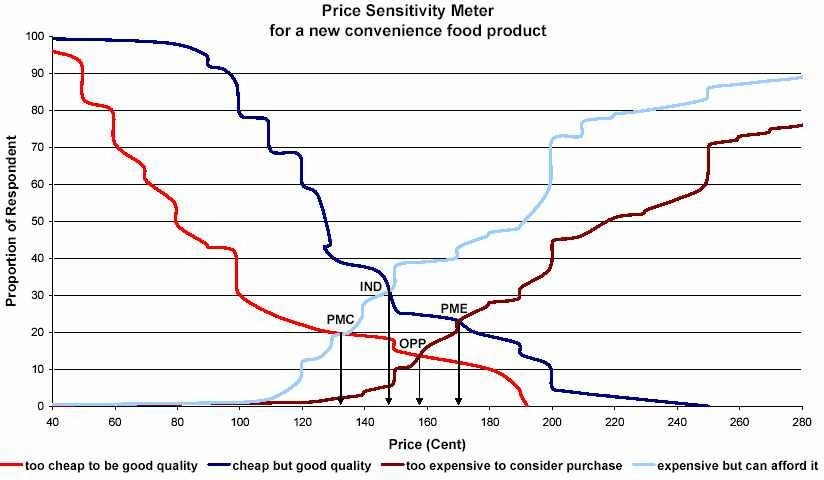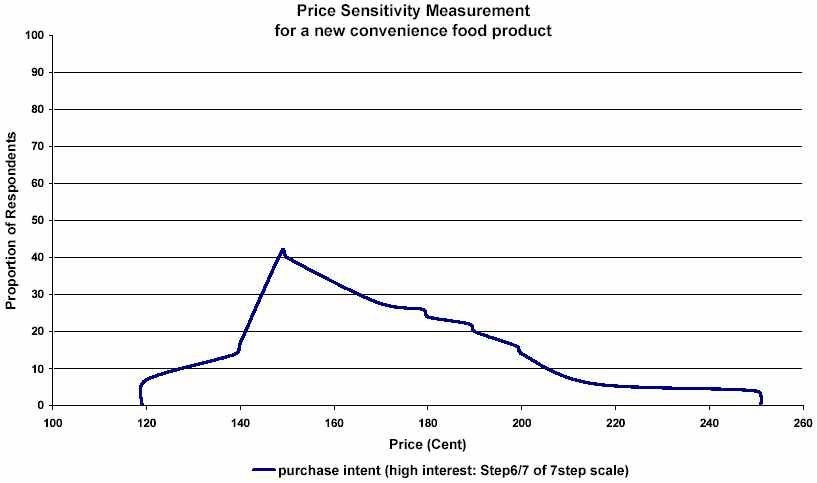Price Sensitivity Meter / Van Westendorp
In case of new product developments, the determination of a reasonable pricing plays an essential role. The IFUMA Pricing test examines
consumers' attitudes to pricing using the PSM (Price Sensitivity Meter).
Conventional methods of price assessment in the context of consumer tests often suffer from "opportunistic" price estimates from consumers point of view. To counteract such answer tendencies, the PSM
chooses an indirect method. Respondents are asked to call amounts to four price thresholds; this is the following price thresholds
• too expensive, I can not afford it
• high price, but I would not afford high quality
• affordable and reasonable price with high quality
• Too low price may not be a good quality
Price Sensitivity Meter - PSM (Van Westendorp)
From the amounts to those thresholds an OPP ( "Optimal Pricing Point") is calculated. This can be represented graphically for the
different test products.
The intersections of the curves are regarded as indicators for the four levels of the PSM.
The PMC (point of marginal cheapness) represents a threshold below which the buying interest decreases dramatically based on the assumption of a lousy product quality.
The PME (point of marginal expensiveness) forms the upper limit of the interval. It represents the threshold at which the buying interest
extremely decreases due to the impression of an extremely high price level.
Other indices are the IND (Point of Indifference) and the OPP (Optimum Pricing Point). The IND is the intersection between the average price level (low-cost but good quality, high-priced but I can
afford it). The OPP is the intersection between the two extreme price levels (too cheap or too expensive). Both indices should be used to identify an adequate pricing of the newly developed
products.
A reasonable price setting is for the above-depicted product between about € 1.48 to € 1.58. The lower threshold value at which the product is found not convincing in quality respect, is € 1.30.
While the upper threshold at which the product appears to be too expensive, is € 1.74.
Overall, it is clear that the Price Sensitivity Meter gives insight into the levels of price elasticity and that it is a useful framework for determining an adequate price of the new
product.
PSM due to Newton, Miller, Smith
As part of an extended model (PSM according to Newton, Miller, Smith) the purchase probabilities for level 2 (low-priced) and level 3 are
(upscale, but I can afford it) determined. The purchase probabilities are shown (top 2 boxes or Level 6/7 = high buying interest) in the vertical.
The descending line is the buying interest for price definition of level 2 again (it is a bargain but good quality), the ascending line in buying interest on condition of level 3 (high-priced but I
can afford it). The intersection or the “top of the mountain” is defined by the "Point of Indifference" IND.
The approach of purchase probabilities at the respective price ratios appear both relevant for new launches as well as for price adjustments of a market introduced product.



